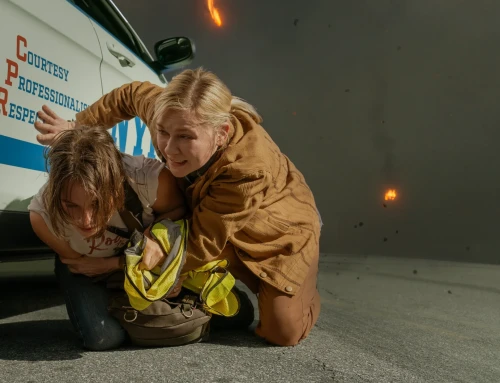Each year the Academy Awards nominates that one handsomely polished Best Foreign Language film that ends up being very schmaltzy and contrived, and most of the time they are just a foreign language variation of an Oscar bait movie. The rules are also awful for how the Academy nominates Best Foreign Film, each country submits only one film to the committee that narrows it down to five nominees for the respected category. Each country ends up selecting their most prestigious movie. This year Germany went with Florian Henckel von Donnersmarck’s latest film “Never Look Away”. Donnersmarck won in 2007 for the 2006 masterpiece “The Lives of Others”, which made my top 10 list in 2006. Sadly this type of film gets nominated over something like Nuri Bilge Ceylan’s Turkish masterpiece “The Wild Pear Tree”, which I recommend a lot more.
Like his Oscar-winning “The Lives of Others”, Donnersmarck explores 20th-century historical tragedies that occurred in Germany, but this time Donnersmarck puts pat coincidences and forced sentimentally over emotional truths making the film come off schmaltzy and unearned. The film certainly shows the power of art reconciling itself over tyranny and conformity, as it explores its story around an artist, Kurt Barnert (Tom Schillling), that is loosely based on German painter Gerhard Richter, who has denounced the films as being “deceptive” of his life. The film saga opens in 1938, in Nazi occupied Germany where a young Kurt is visiting a German art museum with his lovely aunt, Elizabeth (Saskia Rosendahl), in which a Nazi official is condemning avant-garde art as “degenerate” and “tasteless” that is basically subverted by communists and Jews to undermine traditional culture. Kurt’s family, including his aunt hold disdain towards the National Socialists as she embraces the avant-garde art.
Elisabeth ends up enduring mental trauma after she is coerced into handing Adolf Hitler a bouquet of flowers where she is left feeling repulsed by the action. Elisabeth finds herself having a schizophrenic episode where she plays the piano naked and hits herself with a glass ashtray in the head. Blood pours down her head and she is left institutionalized by the Nazi regime. The films first 90 mins or so is quite impressive and certainly the most compelling as it lingers over huge chunks of times with the year appearing in the corner of the screen. The film passes through WW2 and we see Kurt grow up as a young man, in which Schilling plays Kurt for the entirety of the film.
The films strengths center around Kurt attempting to finding his own artistic style and voice. After spending a whole decade under Soviet occupied East Berlin, Kurt is conformed into just painting “Socialist Realism”, that is nothing but Soviet propaganda that narrows his artistic abilities and scope to just being propaganda. The communist school he attends to also holds disdain towards unconventional art as being “self-indulgent”, and Kurt is left more as a artistic conformist than as a innovator. The film does a superb job is exploring Kurt attempting to find his artistic voice and purpose. However the rest of the film falls into a unconvincing and forced melodramatic detours. Kurt ends up encountering a beautiful classmate, Ellie (Paula Beer), whose father just happens to be Nazi gynecologist doctor, Dr. Carl Seeband (Sebastian Koch) that was responsible for sterilizing his Aunt Elizabeth during the war, in which he even ordered her to be gassed with other mentally ill and autistic patients of his inside of a chamber. The professor even performs an abortion on his own daughter so his family line isn’t compromised by Kurt’s genes. Yes this is one sinister and one-dimensional villain that borders between caricature and cartoon.
Once Kurt and Ellie escape East Berlin into the West is where it goes off the end. Cinematographer Caleb Deschanel (The Passion of the Christ, The Right Stuff) does a skillful and luminous job in making the west appear to be more colorful and glossy than the east, where the colors during Nazi and Soviet occupied East Germany are mostly muted and grey, but the rest of the story and approach of Donnersmarck feels very contrived and disingenuous. The film centers around Kurt’s trials and tribulations that unfold with aggressive melodrama and pat coincidences just so his life can intersect with Dr. Seeband’s, where you know the film is just pushing the audience into its punishing 188 running time of a predictable confrontation that even the most naive or novice film goer can predict and anticipate.
Once Kurt begins to find his voice in the capitalist and far more prosperous Western Germany, the characters he encounters are almost like cliches as it unfolds like a clunky pristine picture from the 90’s. He ends up attending an art school in the city of Dusseldorf that is more centered around modern and avant-garde than in paintings, the presentation of the school feels like a segment from an “X-Men” film or even a “Naked Gun” parody. At the school he encounters a teacher that refuses to take his hat off, refuses to look at any of his students art, only for him to reveal himself to Kurt as he observes Kurt’s art through a poorly staged “The English Patient” style flashback where he uses a fedora as a disguise for a severe burn he endured to his head while being shot down during WW2. Its the type of schmaltz you would expect from Hollywood instead of a foreign language film.
The film has a noble message of showing the healing power of art, as Kurt’s artistic masterpiece he is attempting to complete echos his aunts principles on what truly defines art. The art piece he is attempting to complete could hold power in holding the truth of his sinister father-in-law. However Kurt doesn’t have much of a personality in the movie, instead he becomes a romanticized character that is just a vehicle for interludes of important history from Nazi’s to the rise of the Berlin Wall. The romance and passion between Kurt and Ellie is quite strong, only her character takes a backseat in the third act, as the movie becomes a heavy-handed history lesson than being a engaging examination of the complexities of an artist’s life. The film certainly has scope, it’s old fashioned by design, and it’s beautifully crafted and the score is mesmerizing. However the characters are never fully realized and they are sadly inert. The end result of the film hits a lot of false notes where “Never Look Away” is left feeling problematic and hallow.









Only 2.5 stars? This film was so beautiful! My husband and I were in tears with the empowering and powerful message of this movie. The score as you mentioned was very haunting, and the history was well told as it was very critical of both the Nazi and Soviet regimes in how they treated art and humanity.
789572 731931This internet page is often a walk-through for all of the details it suited you with this and didnt know who to ask. Glimpse here, and you will definitely discover it. 664690
What’s up, for all time i used to check weblog posts here early
in the morning, as i enjoy to learn more and more.
Very nice post. I just stumbled upon your blog and wished to say that I’ve truly enjoyed browsing your
blog posts. After all I’ll be subscribing to your feed and I hope
you write again soon! adreamoftrains best web hosting
Amazing! Its truly awesome paragraph, I have got much clear idea
regarding from this piece of writing.
Greetings! I’ve been following your web site for some time now and finally got the courage to
go ahead and give you a shout out from Lubbock Tx!
Just wanted to mention keep up the excellent work!
66816 463083After study some with the weblog articles for your internet site now, and that i truly like your method of blogging. I bookmarked it to my bookmark site list and are checking back soon. Pls consider my internet web site too and inform me what you consider. 207706
5716 559244Youre so cool! I dont suppose Ive read anything such as this before. So nice to get somebody with some original thoughts on this subject. realy we appreciate you starting this up. this fabulous website are some things that is required on the internet, somebody with a bit originality. beneficial work for bringing a new challenge on the world wide internet! 549493
214295 517853Id ought to seek advice from you here. Which is not something I do! I love reading an article that could make people feel. Also, many thanks allowing me to comment! 633527
883934 210580you use a wonderful blog here! do you wish to have the invite posts in my small weblog? 860381
579656 790768Good V I should certainly pronounce, impressed with your site. I had no trouble navigating through all the tabs and related info ended up being truly easy to do to access. I recently found what I hoped for before you know it in the least. 980867
455568 220547My plate is real full and your tryna give me far more food, boy what the fuck is wrong wit you?!|guruisthebomb| 127669